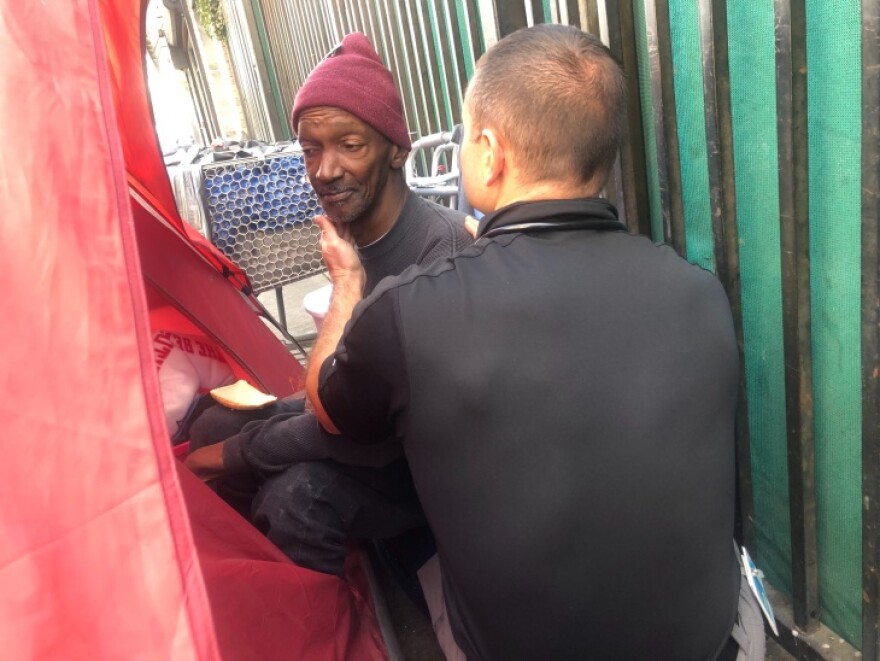Truth matters. Community matters. Your support makes both possible. LAist is one of the few places where news remains independent and free from political and corporate influence. Stand up for truth and for LAist. Make your year-end tax-deductible gift now.
How Health Care Workers Are Meeting Homeless Patients Where They Live

Five days a week, USC healthcare workers hit the streets of L.A. County to meet patients where they live -- on sidewalks, park benches, and under freeways. They see about 30 homeless patients a week.
According to the 2019 LA County Homeless Count, there were nearly 59,000 people living on the streets. A little more than a year ago, USC started a small street medicine team to keep up with the increasing number of homeless patients admitted to Los Angeles County-USC Hospital.
But it's also part of a larger movement that is gaining traction across the nation to address the healthcare of one of the most vulnerable populations.
HOUSE CALLS ON THE STREET
The USC street medicine team is led by Brett Feldman, a physician assistant. He, along with other team members, meet in the morning, in a parking lot across from LAC-USC, and pile into a truck stocked with medical equipment, bottled water, food and blankets.
Then they head out to find their patients.
"We see the patient in the hospital, establish a relationship with them, and then follow up on discharge on the street and wherever the patient goes," said Feldman.
One particular morning, they headed to Skid Row to meet with Mico Fuller, who has been homeless on and off for 20 years.
When Feldman walked up to Fuller's tent, Fuller was tired and bundled up in warm clothing. Feldman asked him how he has been doing.
"I'm tired all the time, weak," said Fuller.
Fuller was diagnosed with chronic obstructive pulmonary disease, COPD, which makes it hard for him to breathe. It's one of the more common serious diseases among people living on the streets.
Feldman asked Fuller if he had his medication, then looked at each pill bottle and told Fuller that they needed to order him more potassium.
BARRIERS TO STREET MEDICINE
Feldman believes that providing this type of continuum of care and compassionate care ensures that an unhoused person might get the same quality of care as a person with a home.
But practicing street medicine is much more complex than practicing regular medicine. Locating a patient can be hard because he or she may not have an address, identification or a phone. If they have an addiction, intellectual disability or a mental illness -- something as simple as taking a pill can be difficult.
But one of the main goals of the team is to reduce the number of times homeless patients go to the emergency room. According to a study conducted by the Robert J. Wood Foundation, more than half of homeless patients who are admitted into the hospital end up back there within 30 days.
Feldman said in 2019, only 8% of his team's patients were readmitted.
BUILDING TRUST
Feldman believes the low readmittance rate is due to the street team's dedication to tracking patients and building a trusting relationship with them. This often goes beyond a medical check-up.
The team first meets the patient at their level by asking them what their goals are. "Some of [the goals] might be small," Feldman said. "Like getting an ID so they can apply for a job."
But, he added, "it might be them knowing that somebody cared about them when they died on the street."
Thirty-five years ago, Dr. Jim O'Connell started the Boston Health Care for the Homeless Program, one of the first street medicine programs in the U.S. Today, with the homeless population growing in many cities, the need to treat them, O'Connell said, is growing.
"We're going to have to relook at the way we do things and send all the health care providers and their support systems out to wherever people are," said O'Connell.
FINDING A FUTURE
That day on Skid Row, Feldman and his team checked Mico Fuller's heart rate and found it dangerously low. So they put him in an Uber to go to the hospital with a team member.
But they assured him he doesn't have to go back to his tent after he gets out. The team found him a bed at a recuperative care center at the Martin Luther King Jr. Medical Campus in South L.A., and Fuller can stay there until he gets permanent housing.

Now that Fuller is not on the streets anymore, he said he wants to reconnect with his daughter.
"I am proud of her and I do miss her," he said.
Their relationship severed because he said he didn't want to embarrass her because he was homeless, but now, his life and health are looking different.







